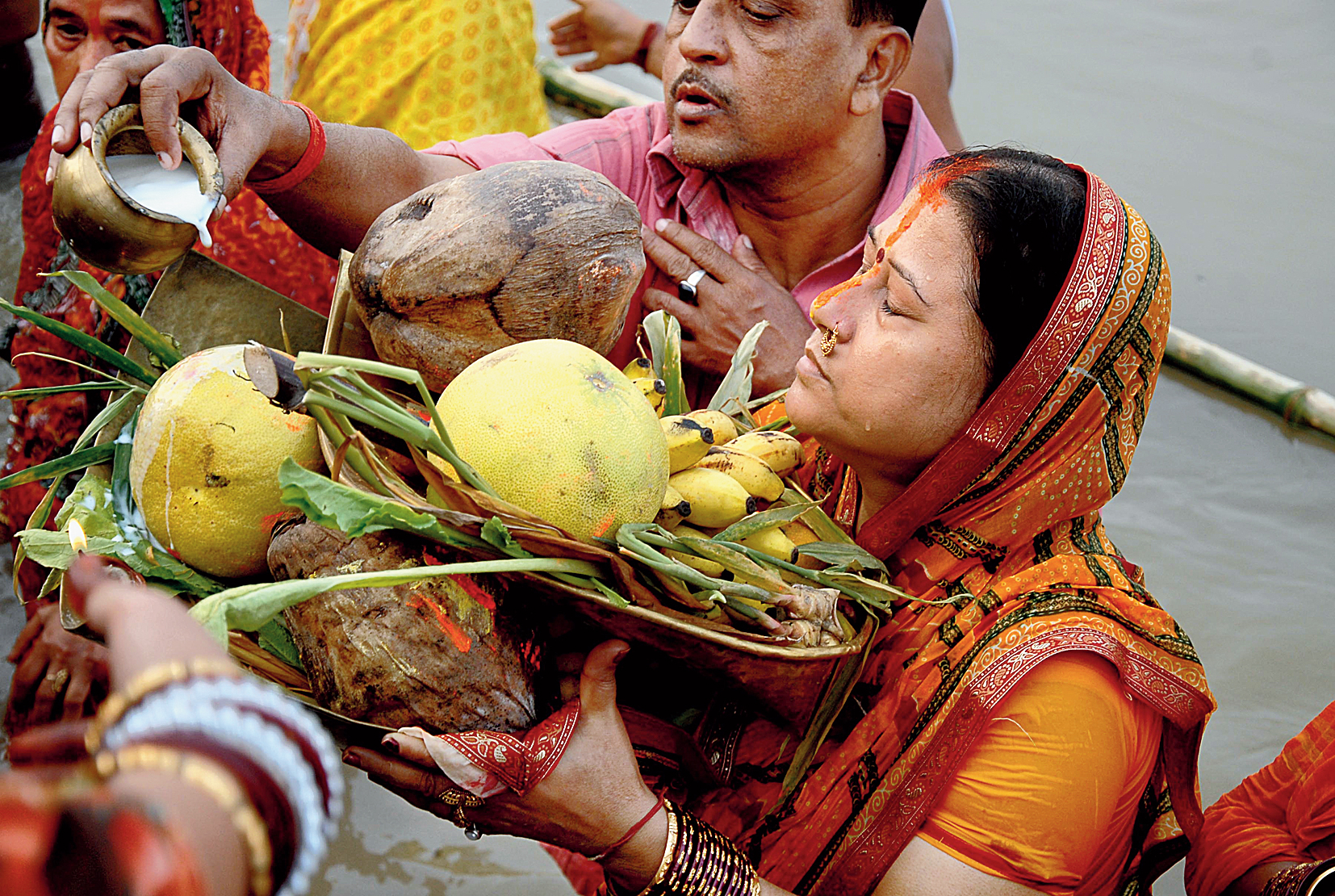Modern day Chhath has emerged as the most revered and popular community festival of Bihar, in which all strata of society participate with equal zeal and sincerity though with many new manifestations and amendments. But the worship of the Sun God, which constitutes the essence of the festival, has been prevalent in the Magadh region and in other parts of Bihar for millennia.
Though the role of fire got minimised in Aryavarta (present day Uttar Pradesh) after the Later Vedic Phase (1000-600 BC), its use increased further east, in the Bihar region, from 600 BC onwards as new settlements emerged in Magadh.
The pre-historic settlements of the hilly and the jungle terrain of South Bihar regions and Northern Jharkhand were the source of the sustenance for nature worshippers, including the followers of the sun/fire cult. In recent times, more than 42 rock shelters/cave settlements belonging to the pre-historic as well as early historic period have been deciphered in the districts of Nawada, Jamui, Giridih and Jamui.
The Taradih excavations of Bodhgaya have unearthed artefacts since the Neolithic period. Several fire pits have been found which also justify the worship of fire/sun god as continuity since pre-historic times.
The Aryanisation of the Magadh region, since 600 BC, superimposed the Rig Vedic (1500-1000 BC) concept over the local tradition of the sun/fire cult in the area.
The first manifestation of the Sun God in the Mahabodhi pillars of Bodhgaya in the art form during the Saka-Kushan period is thus natural. As such, we also find ‘Sun God’ appearing on Kushan coins during AD 200-300.
The rapid march of the Magadh Empire during 600 BC and the subsequent rapid urbanisation of the Magadh region further regenerated and popularised the local prehistoric sun/fire cult among the urban gentry and the ruling elite of Magadh region.
LINK BETWEEN WORSHIP OF SUN GOD AND MOTHER GODDESS
Worship of the Mother Goddess is associated with the “fertility cult”, which had its origins in primitive agricultural societies of the world. Discovery of idols of Mother Goddess in various matured forms at the sites of the Indus Valley Civilisation prove beyond doubt that the worship of Mother Goddess has been popular in India from pre-historic times.
The Mahabodhi Pillars of the Saka-Kushan times have revealed two distinct images carved out of stone: (i) The Sun God and (ii) The Primordial Mother Goddess.
While the image of the Sun God was conceived during the Rig Vedic phase, the Primordial Mother Goddess was still in the pristine form, as the River Goddess and was conceived from the folk traditions of Aryavarta.
With the evolution and the advancement of the agrarian economy in Aryavarta, the worship of Mother Goddess emerged as the most popular form of worship in the folk tradition.
The River Goddess slowly evolved in the mindset of the village communities of Aryavarta during the Late Vedic Phase (1000-600 BC). The concept of the River Goddess of Aryavarta travelled far and wide during 600 BC to AD 300 from Northwest India to Eastern India in the Indo-Gangetic belt and was popular among the people of the time in general and the village communities in particular. The Mahabodhi Pillar depicts the River Goddess as sitting on a ghata (vase or kalash) and black-clouds representing two elephants are pouring water on her head by their trunks, signifying heavy downpour during rainy season. Later, the River Goddess has been identified as the Gaja Lakshmi form of Goddess Lakshmi in the Brahmanical pantheon but it also survived in its pristine form, in the folk tradition of Magadh (in particular) and Bihar (in general) in the form of Chhath Puja.
Interestingly, the most significant utensils used on the occasion of Chhath Puja are a holy pot (kalash) and the chaturmukh dwip. The kalash signifies the Mother Earth or Mother Goddess, which proves beyond doubt the inter linkage between the Sun God (male divinity) and the Mother Goddess (female divinity).
The Chhath Puja is directly rooted to the well being of the agricultural society as the worship of the Sun God is directly related to the harvesting season of two major crops of Bihar: kharif and rabi. The harvesting time of kharif crops is the month of Kartik (October-November); and that of rabi is Chaitra (March-April).
The present form of Chhath Puja was conceived during the medieval period. The various aspects of Chhath Puja got crystallised with the stabilisation of the medieval period as we can see the devotees urge the Sun God to provide them good health, male progeny and wealth (good harvest and monetary gain), a general urge for all classes of the agrarian feudal society of the central Gangetic plain of Bihar.
THE SIGNIFICANCE OF COCONUT, PAAN AND BANANAS
Seasonal fruits and vegetables (of the Bihar eco-system) are needed for Chhath Puja, but the only exception is coconut which is known as Kanchan Phal. It signifies that coconut is resistant to rotting for months due to its sclerenchymatous outer cover and can be safely transported from one part of the country to another. In the ancient and the medieval period coconut (but not the green coconut) was very much part of Bihar’s dietary supplement.
Significantly, betel leaf (paan) and bananas had been brought from the Southeast Asian eco-system in the ancient period, probably by Brahmin and Buddhist monks, but both had been internalised in the cultural traditions of India. Both paan and bananas predate the medieval Chhath Puja traditions and are essential part of the rituals.
Of late, pineapples and oranges have also become a part of the Chhath Puja offerings.
Orange is unknown in the wild state, it is assumed to have originated in southern China, northeastern India, and perhaps southeastern Asia from ancient times but now, it is available in the market due to the availability of rapid communication. Similarly, pineapples, a fruit of the eco-system of northeastern states, are now readily available in Bihar during the Dala Chhath of Kartik.
The use of some of today’s common fruits, vegetables and pulses is not seen in use by devotees due to their origin from other eco-systems like potatoes (Latin America), onion (Central Asia), apples (Central Asia), lentil (Central Asia), cauliflower (Syria and Europe), cabbage (Mediterranean countries) among others. Instead, the local edibles are in use e.g. sweet potato, singhara, pomelo, Bengal gram (chana dal) and turmeric saplings.
Jaggery (gur) from sugarcane is the traditional sweetener of Indian cultural tradition and is an essential part of Chhath Puja festivities.
But now some devotees also use sugar crystals, popularised by the British who opened sugar mills in north Bihar and elsewhere during the early decades of the 20th century.
The author is a research writer and freelance journalist. He is the author of the book, The Making of the First Cantonment of the Indian Subcontinent In Patna, 1757-1768











